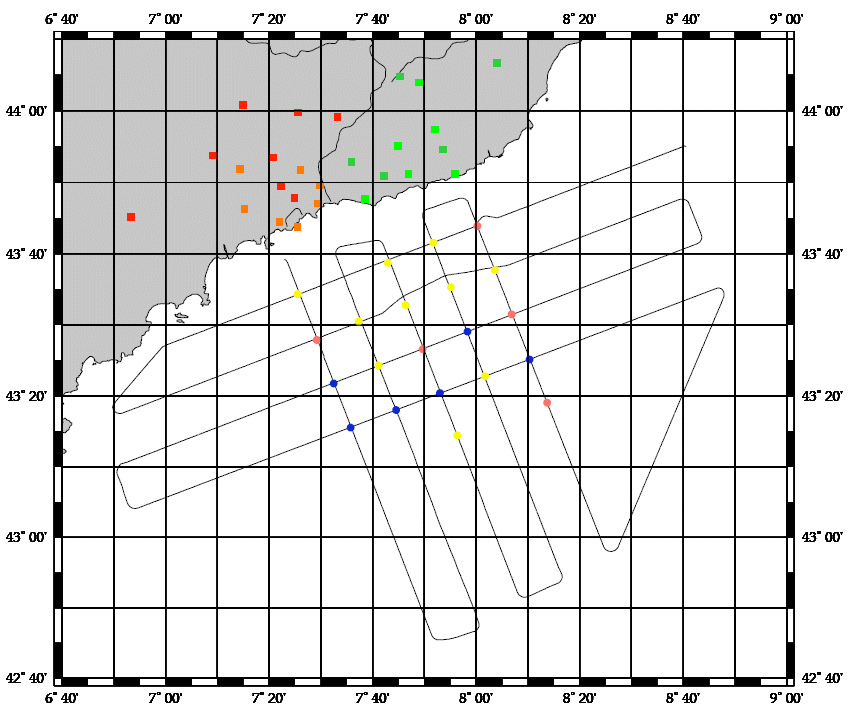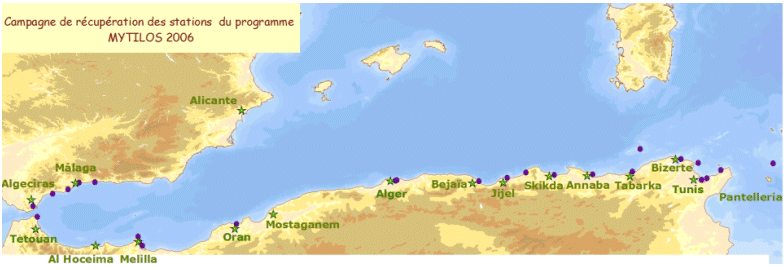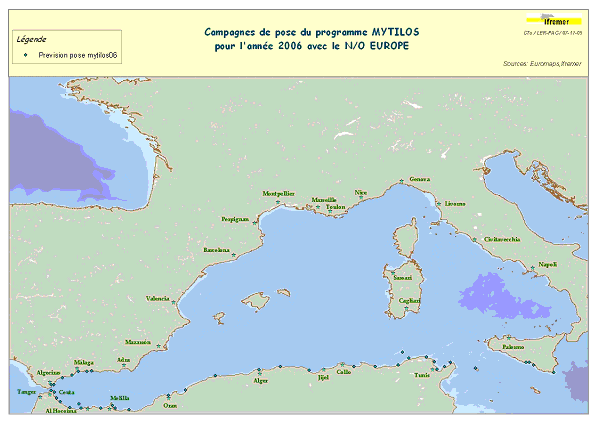Category
Campañas extranjeras
130 record(s)
Type of resources
Categories
Topics
INSPIRE themes
Keywords
Contact for the resource
Provided by
Years
Formats
Status
-
Studying the role played by formation of deep water in the chemical composition and budgets of matter in the Mediterranean. Understanding the relationships between the way plankton food webs are organized and the hydrodynamic structures. The related project is MISTRALS - MerMEX.
-
The aims of this cruise were to elucidate the processes responsible for controlling iodocarbon concentrations and provide a dataset that can be used to develop modelled estimates of iodocarbon sea-air fluxes in tropical Atlantic waters.
-
Acoustic measurements.
-

<p style="margin-left:0cm; margin-right:0cm">This multidisciplinary and integrated study comprises geophysical, sedimentological and (bio)geochemical data and aims to present a holistic view on the interaction of both environmental and geological drivers in cold-water coral mound development in the Gulf of Cadiz. In this context, it was fundamental to obtain "samples from the deep" to explore and characterize the biodiversity thought (1) geophysical and video imaging, (2) targeted microbiological profiling, (3) evaluation of present and past oceanic conditions.</p> <p style="margin-left:0cm; margin-right:0cm">Targeted microbiological and biogeochemical transects with long sediment cores were proposed to elicit the 3D spatial architecture and diversity of the microbial mound community and its possible role in slope stabilization. Off-mound cores were also targeted in order to evaluate present and past oceanic conditions by dating of the cored sequences and by reconstruction of water mass and sedimentary dynamics variability for eliciting the time frame of natural biodiversity changes.</p> <p style="margin-left:0cm; margin-right:0cm">The key objective aiming to investigate the microbial diversity and the functional link microbes-metazoans was addressed through biogeochemical approaches (biomarkers), molecular fingerprinting (DGGE, 16S rRNA), fluorescence in situ hybridization (FISH) and laboratory culture. This also includes the analysis of microbial infestation of coral frame builders and fauna-microbe interactions, in general, and the analysis of microbially mediated processes of carbonate precipitation, at various sites and scales: coral mucus, carbonate crusts, mound slopes, mound interior.</p> <p style="margin-left:0cm; margin-right:0cm">The sites targeting was mainly prepared by geophysical surveying (high-resolution sparker seismics, multibeam bathymetry) and ROV imagery, performed by RCMG (Ghent University). Especially the location of all on-mound core sites was determined from interpretation of the ROV Genesis dives during the CADIPOR III campaign of June 2007 on board of R/V Belgica. Additional information was made available through cooperation within past or ongoing European projects such as ESF EuroMARGINS "Moundforce", EC FP5 RTN "EURODOM" and EC FP6 IP "HERMES". Although the MiCROSYSTEMS-MD169 cruise focus was on the Pen Duick Escarpment (PDE), (8 sites, Figures 1 and 2) also other sites such as Conger Cliff (Vernadsky Ridge) and Mercator Mud Volcano were sampled. Special attention was given to the two proposed drill sites for IODP Full proposal 673 "Atlantic Mound Drilling 2: Morocco Margin". A total of five main site locations were identified:<br> 1)The Pen Duick Mounds: Alpha, Beta, Gamma and Epsilon Mounds,<br> 2) The Vernadsky Ridge mounds: Conger Cliff,<br> 3) A depression site at the foot of PDE,<br> 4) Palaeoceanographic reference sites,<br> 5) Mercator Mud Volcano.</p> <p style="margin-left:0cm; margin-right:0cm; text-align:center"><img alt="" src="https://campagnes.flotteoceanographique.fr/campagnes/8200100/images/426.png" style="height:244px; width:500px"></p> <p style="margin-left:0cm; margin-right:0cm"><em>Figure 1: Shipboard map of the SF11 multibeam bathymetry with site tracks.</em></p> <p style="margin-left:0cm; margin-right:0cm">The coring and subsampling strategies used during this campaign were predominantly site-dependent, distinguishing between "on-mound" and "off-mound" sites. Every on-mound site was cored at least two times; one core for geochemistry and microbiology, to be sampled immediately on board, and a second core for sedimentology, palaeoceanography and chronostratigraphy, to be left unopened and stored immediately.
-
The cruise is a component of RAPID-WATCH, whose objectives are: to deliver a decade-long time series of calibrated and quality-controlled measurements of the Atlantic MOC from the RAPID-WATCH array and; to exploit the data from the RAPID-WATCH array and elsewhere to determine and interpret recent changes in the Atlantic MOC, assess the risk of rapid climate change, and investigate the potential for predictions of the MOC and its impacts on climate. Objectives of this cruise: to recover, calibrate and redeploy moorings from the eastern boundary and mid-Atlantic ridge subarrays of the 26.5N line of RAPID moorings.
-

Characterizing the variability of hydrological and current features and particulate fluxes on the continental rise of the Gulf of Lion and in the deep convection zone. Monitoring of deep benthic communities in the western canyons and on the continental rise of the Gulf of Lion.
-
This cruise is part of the UK science contribution to the international SOLAS project (Surface Ocean Lower Atmosphere Study www.uea.ac.uk/env/solas/) which aims to advance our understanding of environmentally important interactions between the ocean and the atmosphere. Data collected during the cruise will help to determine the influence of coastal/shelf regions (20-200 km offshore) on microbiological activity in the ocean and chemical interactions between the ocean and the atmosphere. Deep water containing high concentrations of nutrients such as nitrate, and gases such as nitrous oxide and methane, rises to the surface (upwells) at the Mauritanian shelf edge and moves offshore. These nutrients can be chemically altered by sunlight and used by bacteria and microscopic plants to grow. The gases escape to the atmosphere and contribute to global warming. This cruise will sample the upwelled water as it moves offshore measuring its temperature, salinity, nutrient and gas content and the impact this water has on microbiological growth and atmospheric composition in order to improve international global climate models. The cruise has three scientific objectives: 1. To determine the role of upwelling on the supply, loss and air-sea exchange of climatically important gases produced by plankton 2. To determine the role of light in breaking down upwelled and recently produced dissolved organic matter and in producing climatically important trace gases 3. To determine the impact of nutrient enriched upwelled water on the spatial and temporal variability of plankton community structure and activity and resultant influence on biogenic gas flux
-

Assessment of chemical contamination in coastal water masses (Spain, Morocco, Tunisia, Sicily canal), using artificial stations of mussels. The MYTILOS1 cruise aimed to utilize the RINBIO network methodology around the western Mediterranean, in the northern part of the NW Basin. Experiments run in the French Mediterranean since 1996 by IFREMER were to be extended to Southern Mediterranean coasts, i.e. Spanish, Moroccan, Algerian and Tunisian coasts, as well as the Sicily Canal in Italy, on the basis of a standardized protocol. The data from MYTILOS2 cruise will supplement those obtained in 2004 and 2005 during the RINBIOC1 and MYTILOS1 cruises by including the coasts of North Africa, Southern Spain and the island of Pantelleria. In addition, the results will be used to complement the chemical contamination budget drawn up in the framework of the European Water Framework Directive's implementation. The survey was based on 2 major actions: 1) Artificial mussel stations were placed and recovered along a shoreline between Malaga (Spain) and Sicily (Italy), including Morocco, Algeria and Tunisia. 2) Sediment samples in addition to mussels samples were taken upon the partners' request. This falls under the MEDICIS project.
-
<p>The purpose of WestMedFlux is to study thermal fields in ocean-continent transition zones in the Western Mediterranean, and the role of fluids and salt diapirs on the thermal field.</p>
-

Assessment of chemical contamination in coastal water masses (Spain, Morocco, Tunisia, Sicily canal), using artificial stations of mussels. The MYTILOS1 cruise aimed to utilize the RINBIO network methodology around the western Mediterranean, in the northern part of the NW Basin. Experiments run in the French Mediterranean since 1996 by IFREMER were to be extended to Southern Mediterranean coasts, i.e. Spanish, Moroccan, Algerian and Tunisian coasts, as well as the Sicily Canal in Italy, on the basis of a standardized protocol. The data from MYTILOS2 cruise will supplement those obtained in 2004 and 2005 during the RINBIOC1 and MYTILOS1 cruises by including the coasts of North Africa, Southern Spain and the island of Pantelleria. In addition, the results will be used to complement the chemical contamination budget drawn up in the framework of the European Water Framework Directive's implementation. This falls under the 'MEDICIS' project.
 Catálogo de datos del IEO
Catálogo de datos del IEO